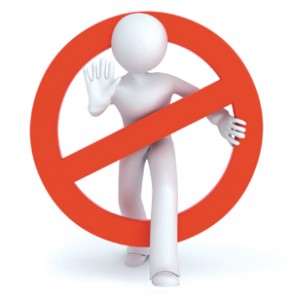Many doctors are working harder now than ever. Marketing and recruiting are mainstays for a successful practice. However, we all know that when you seek new patients, anyone can come through your doors. Learning the lesson that you don’t have to treat everyone who enters your realm will save you precious time, emotional strain and financial hardship. Keep in mind that it’s the 5 percent of patients who can seriously disrupt a good practice.
A good formula to follow is to look out for the potential troublemakers who may come through your door; the patients to whom you should just say “no thank you,” particularly for any personal injury cases. Remember, you are an independent professional. You can pick your location, your fees, your treatment methods, your hours and ultimately, your patients. Happy patients will make for a happy practice.
Consider the following list of troublemakers and see which ones seem to be familiar among your current or potential patients.
- I Don’t Like Them
Trust your instinct. You don’t need a reason. If there seems to be something inherently negative between you and your prospective patient, it is time to move on.
More importantly, listen to your front-office staff. They are often more sensitive than you to these matters. Although it may not be quite rational, just trust the force.

- Multiple Doctors
Anyone can have one bad marriage, but three or four? “Doctor hoping” is a clear behavioral sign of an unstable patient. Some doctors like to think that the patient finally came to them for the ultimate relief, only to be disappointed when the patient moves on and trashes them to the new doctor. Be acutely aware if the patient always has negative things to say about all their prior doctors. You will be next on the list. - Won’t Pay Co-Pay
They forgot their checkbook, wallet or credit card. That doesn’t work in a restaurant. It should not work in your office, either. When the money is missing, it’s the first sign the patient is taking advantage of you. This is particularly true with personal-injury cases. Too often, personal-injury reimbursements are slashed by unscrupulous attorneys.
I strongly recommend that all personal-injury patients be required to pay decent co-pays for every visit. This is to protect the clinic, pure and simple. If an injured patient will not pay you a modest $20 for their personal-injury care at each visit, they certainly won’t be fighting to pay your whole bill when the personal-injury case is finally settled.
- The “Slam Dunk”
When your patient tells you their personal-injury case is perfect, they will either ask you to reduce your fees at settlement or blame you if they didn’t get enough money. Some delusional patients expect you to be so “grateful” for their “easy” case that you should give them major consideration. That’s baloney. You are not treating a legal case. You are treating a complicated human with all sorts of variations. - The Quarrelsome Patient

It’s obvious that they are unhappy with life. That includes you and your staff and anything and everything from parking reimbursement to a small delay in seeing them; it’s basically a constant barrage of unfounded complaints. Don’t worry about being subtle. The quarrelsome patient is immediately obvious right at the first meeting. Avoid them at all costs and protect your practice. - The Know-It-All
The “wise guy” patient is a nuisance. You might be able to tolerate them, if you lay down the law immediately. If they are incorrigible, they will constantly interrupt you while you are taking their history. They will not listen to you. They will not show up on time for their appointments, do their home exercises, or be compliant. This patient is unsympathetic and jurors won’t like them. They end up sabotaging their own case. - The Unfamiliar Injury Syndrome
Avoid areas and patients with a learning curve that is too steep. This may not necessarily be the patient’s fault, but it can still cause problems.One example that comes to mind: a patient who very carefully explained to the chiropractor and their staff that he suffered from Gaucher’s disease, a rare genetic disease found among people of Eastern European descent. The symptoms of Gaucher’s disease can include bone pain, degeneration and fractures. Bone disease may lead to neurologic problems such as compression of the spinal cord. Of course, the doctor
was sued after only three visits. The consequences of a mistake are too high. Refer to an expert. - The Gypsy
The gypsy patient is lethal. They know how the personal-injury system works. The gypsy patient has probably visited every single doctor of chiropractic in America. There must be a school out there to teach them how it all works. They explain they have been through personal-injury cases before and suggest cutting out the “middle man” attorney. They will happily sign a promissory note.Of course, the next thing the gypsy does is take your bill and chart, and settle. However, they conveniently forget to pay you. You go looking for them, but of course, the gypsy patient has vanished into thin air.
- The Hand-Off Patient
The patient got your name from some big-shot doctor, but that doctor was too busy to treat him. You are their second choice.Look hard at this case. Certainly, talk to the prior doctor and see what you can learn. Examine this patient carefully. There may be a strong reason why the other doctor would not take this patient.
- A Relative or Friend
The chiropractor insists, “I would not let anyone else touch my wife!” So the good doctor treats his wife for an accident she was in and bills more than $5,000.At trial, when the doctor is asked if he always charges for adjusting his wife and children, and replies he does not do so, the case rapidly vaporizes.
“Be acutely aware if the patient always has negative things to say about all their prior doctors. You will be next on the list.”
Too many times, when you treat your spouse, in-laws, etc., especially for money, and the case doesn’t turn out well, you are one to take the blame. Think of it this way – you’ve got to deal with that resentment at every Thanksgiving dinner for the rest of your life. No good deed goes unpunished. You are hereby forewarned.
Rules to Live ByThese 10 examples of the types of patients you should OPERATE YOUR PRACTICE CONTINUED FROM PAGE 18 avoid apply to everyone who provides care: doctors, lawyers, dentists and even candlestick makers. You will make your life happier and your practice more profitable by spotting these bad-news cases right away and exercising your “patient delete” button more often.
